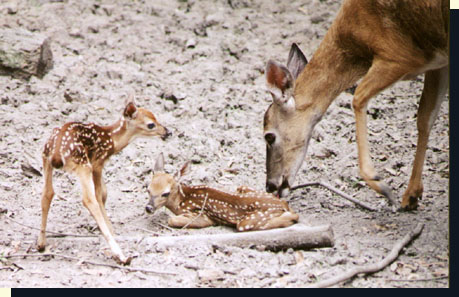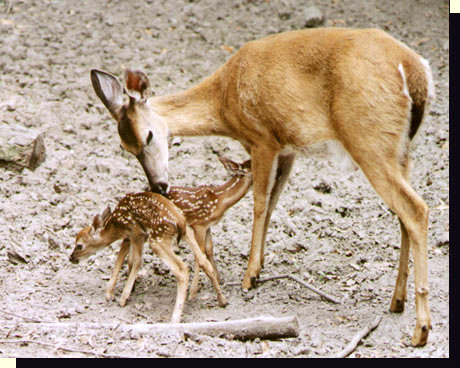

 |
This doe chose a dry pond bottom for giving birth, possibly because of the clear view that would let her more easily spot approaching danger. We have seen a fallow doe similarly using a broad, clear sink hole to give birth. |
| You can see the doe giving her second born fawn encouragement to get up so she can lead them both to safety in their hiding spots. The first fawn is already nosing around for milk! | 
|
| Does can give birth
to from one to three fawns, uncommonly four, and, this is hearsay, but
five are said to have been born to a single doe. Usually the does
have two fawns. Sometime before delivering her new fawns, the mother doe will drive off last year's male offspring. Male deer have no inhibitions about trying to breed their own mother. She will however tolerate her female offspring, and whitetail often form long term maternal family groups. The actual birth can take minutes to hours. It is touching and almost painful to watch new fawns, struggling to manage their long, stick like legs, some of them collapsing repeatedly, resting between efforts. At this stage, right after birth, the fawn does not know that it is a deer, and might go to, and follow, anyone. The mother doe in these first "getting to know you" days has to sometimes claim back a fawn that goes to another doe, ready to follow her as its mother. Sometimes a fawn that tries to call another doe "mom" will be bluntly run off. Sometimes a doe will accept another's fawn that wants to nurse. The mother cleans, inspects, and then leads her fawns from the birthing area to hide them while she returns to eat the placenta. She does this to remove the scent of blood, so they will all remain as invisible to predators as possible. The placenta is most likely a source of quality nourishment at well to help the doe who now has to produce rich deer milk. The hiding fawns are helped by their having no body scent for their first few days.
When in a few hours the fawns are more oriented, they will hide with a vengeance. If they sense any movement at all they might drop to their bellies like trained soldiers; sometimes they just collapse like a pile of sticks and will not move from even the most awkward position. If they are old enough to be curled up in the typical "cute fawn" position, they will hold as still as the earth, keeping their heads up and alert or tucked down if that was their posture when they spotted trouble. Some might bolt at a thing's approach, but others, usually those who are only hours to a few days old, will hold tight even as a mowing machine comes down on top of them. An amazing example of the resourcefulness of a fawn was displayed when I had to retrieve twin fawns whose mother had died from mastitis. I found one twin, but couldn't find the other. I walked the pen, which had foot high grass, over and over. I checked the fence closely to see if he could have escaped. Nothing. Finally, in my continued search, I caught something out of the corner of my eye. It was the three day old fawn slipping along the fence. He had been moving from spot to spot to elude me.
Does and fawns do not instantly bond. The bond gradually builds by suckling and mutual grooming. The doe stimulates and consumes the urine and feces of the fawn, again to eliminate scent, and again probably as a source of nourishment. A doe will sometimes protect her fawn if the predator is small, but more often she will not. Many fawns are lost to predators and does frequently must stoically move on without the fawns they produced, this breeding season a loss. The mother-fawn bond can also be broken in cases of starvation in which a doe will drive her own fawn away from a food source. That is nature's strict law for the species: the most likely to survive come first. A doe can make more fawns, but she must be fed, alive and healthy to do it. |
|
THE SPECIES HABITAT DIET DIGESTION SURVIVAL RANGE BREEDING |
COURTSHIP ANTLERS FAWNS TAME WHITETAIL MULE DEER AND BLACKTAIL THEIR FUTURE ANIMALS |